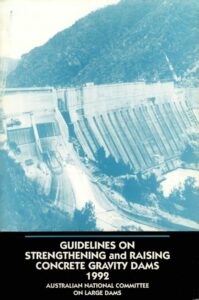- Home
- Resources & Information
-
-
Resources & Information
-
Member Resources
- ICOLD Website Login
- ICOLD Circulars
-
-
- News & Events
- Membership
-
-
ANCOLD Membership
-
-
-
- About Us
 Concrete gravity dams were a popular choice for dam construction, up to the 1950s and a large number have been built in Australia. They vary from relatively small structures to very large ones such as Warragamba Dam, one of the world’s largest domestic water supply dams.
Concrete gravity dams were a popular choice for dam construction, up to the 1950s and a large number have been built in Australia. They vary from relatively small structures to very large ones such as Warragamba Dam, one of the world’s largest domestic water supply dams.
A large proportion of these structures have required or still require modification. Prior to1930 many dams were constructed with somewhat optimistically steep backslopes because the effect of uplift was not fully understood. Recent developments in meteorology and hydrology have shown that the original spillway design capacities are low by today’s standards, and many therefore require a raising of the dam crest level and/or provision of additional spillway capacity.
Apart from the need to upgrade the original design to revised standards, the continual increase in demand for water supply has required enlargements for increased storage capacity. The raising of existing dams for increased storage is frequently attractive form both the cost and the environmental point of view. Large storage volumes can be obtained from moderate increases in crest level while requiring minimal land acquisition and having comparatively minor additional impacts on the established environment.
The modification of existing structures is generally a far more difficult assignment than the construction of a new structure. Not only has the design to contend with the original site conditions but also with and old structure suffering form decay and the results of deficient construction and material standards. There is also often conflicting and/or little useful documentation.
The investigation and design of dam strengthening and enlargement works present some of the most challenging work available to civil engineers. Australian engineers have had considerable experience in recent years with strengthening and enlargement of gravity dams
and several major projects are currently under investigation/construction. While this work has been largely directed at the development of post-tensioned anchorage systems, a variety of alternative proposals have been used for particular situations.
In an ideal world all existing structures would be upgraded to the same standard as modern designs provide for new structures. This is frequently impractical for a variety of reasons and often difficult decisions need to be taken to reach an acceptable compromise between dam safety and the limited availability of funds. Each structure needs to be assessed individually, and necessary compromises should be taken with great care.
These Guidelines aim to define the problems involved in upgrading concrete gravity dams, to indicate the type of solutions currently being developed and to document Australian practice in areas where considerable expertise has been developed. The Guidelines will be reviewed periodically and comments from users both within and outside Australia will be welcomed.
$108.00

ANCOLD is an incorporated voluntary association of organisations and individual professionals with an interest in dams in Australia.